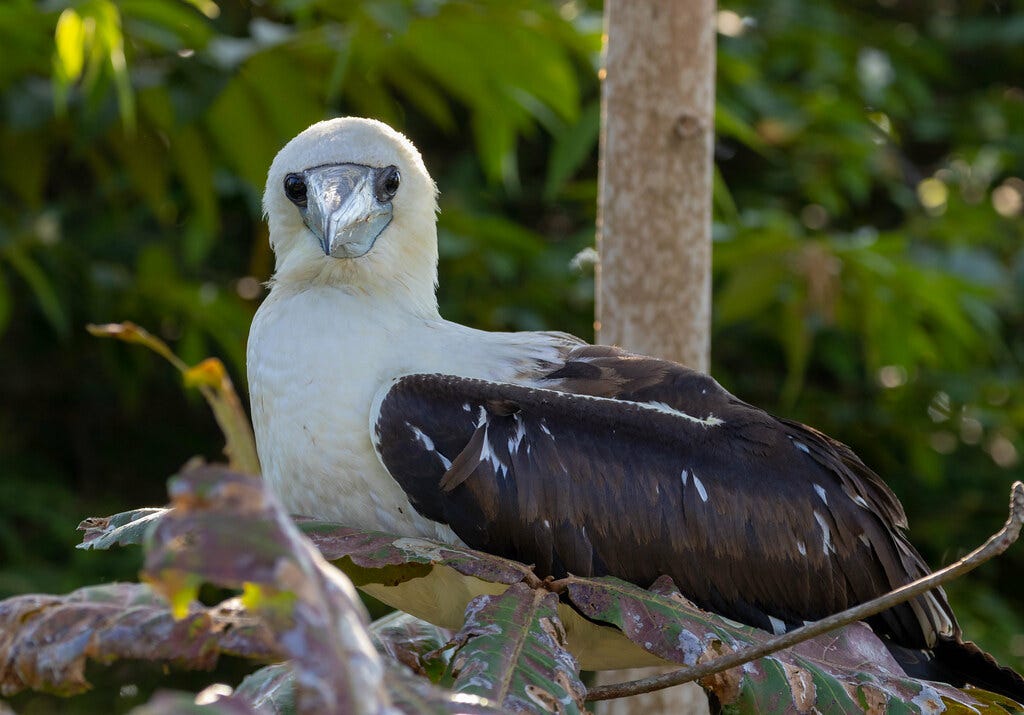It’s almost Christmas!
I’m rounding up a couple of merry birds for this month’s newsletters, so today, I thought we could focus on some birds that literally have the word ‘Christmas’ in their name!

Have you ever heard of Christmas Island?
It’s a small little Pacific Ocean atoll in the northern Line Islands.
An atoll is a ring-shaped, or circular-shaped, island made out of coral reefs. Many other islands around the world are made from rock or volcanic rock, but atolls are made from coral. You can find atolls in places like the Maldives!
The Line Islands are a chain of 11 atolls at the geographic center of the Pacific Ocean. They form a line, and that’s how they got their name.
So the Christmas Island is one of these 11 atolls!
Christmas Island is part of the Republic of Kiribati, and it got its English name because Captain William Mynors of the British East India Company named the island after sighting it on Christmas Day.
And did you know?? SINGAPORE (the island and country I live in) used to own Christmas Island!!!
This is despite the 1,327 km distance from Singapore to Christmas Island, and the fact that Christmas Island is closer to Indonesia than Singapore?
But in 1958, the island was excised from Singapore and sovereignty was transferred to Australia. At this time, Singapore was still a Crown colony of the United Kingdom.
As part of the transfer, Australia paid Singapore a cool £2,800,000 as compensation for lost phosphate revenue. That’s about £50 million in today’s currency after adjusting for inflation!
Phosphate is an electrically charged particle that contains the mineral phosphorus.

The island was initially uninhabited, but this changed following the discovery of phosphate on the island by naturalist Sir John Murray during one of his expeditions to Indonesia. The discovery prompted calls for the British to establish a settlement on the island to extract phosphates and other minerals or resources.
Today, Christmas Island is home to less than 2,000 inhabitants, mostly of Asian-Australian descent.
It is also home to many awesome and wonderful species of birds! As well as crabs, sharks, and more.
The birds of Christmas Island!
Starting with the Frigatebirds! We learnt a little about them in a previous article, so today, let’s explore the species as a whole.
There are five different species of frigatebirds that can be found near tropical and subtropical coasts around the world. These birds can fly for hours, days, or even weeks at time due to their large wingspan. They have a slender black body and wings.

Christmas Island is home to three of these five species: the Christmas Island Frigatebird (aptly named!), as well as the Great, and Lesser Frigatebird.
Frigatebirds are seabirds, and they get their common name from the frigateships of France, a sort of fast-moving and very dominating warship. That’s probably because the birds themselves are huge and dark-coloured and fast, impressive fliers.
They are so bright and red and merry-looking. The perfect subject for today’s Christmas-related birds!
These birds are so cool for a multitude of reasons. They have ginormous inflatable red throat sacs, they love clamping their big beaks onto smaller birds and shaking them upside down so they puke up their previous meals, and they are known for sleeping while flying!
Please read my previous post for more info!
Christmas Island predators
The island is home to two unique species found nowhere else in the world: the Christmas Island Hawk-owl and the Christmas Island Goshawk. These birds are endemic to Christmas Island!
Endemic means the species is native and restricted to a certain place. It can also be used to describe diseases: endemic means a disease can be regularly found among particular people or in a certain area, whereas pandemic means the disease is prevalent over a whole country or the world.
Unfortunately for endemic species, being restricted to one place means if their hometown is destroyed, the species has little chance of recovering and breeding elsewhere. In the example of the Christmas Island Hawk-owl, there is an estimated 500 pairs remaining in the island (so perhaps just over 1,000 individual birds?)
Similarly, the Christmas Island Goshawk is considered endangered, and there are only a few hundred individuals estimated to be left on the island. This species mostly eat other birds, but have been reported by the islanders to take grasshoppers from road sides! How cute!
However, the sad news that these birds are endangered is not the merriest of information…
Nesting only on Christmas Island - Abbott’s Booby!
We learnt about Boobys in a previous article. I love these big dumb birds, and Christmas Island is home to a couple different species of them!
However, one species, the Abbott’s Booby, nests only on Christmas Island. (I wonder why they like the place so much?) Partners mate for life, and maintain the same nest site throughout their lives. They are creatures of habit, and that is why current mating pairs of Abbott’s Booby return to their old nest sites.
Just like the birds of prey we read about, a restricted range can spell doom for these birds - they have little chance of recovering and breeding elsewhere if the need arises. Today, there is an estimates 3,000 pairs of Abott’s Booby (not too shabby!) but the population is reducing due to the clearing of Christmas Island’s forest, for phosphate mining.
These birds only nest on Christmas Island, though, and can be found in many other coastal areas nearby. Abbott's Booby is the largest of all booby species, and is adapted to long-distance flight - so hopefully, the birds can learn to nest elsewhere, bringing the gift of wonderfully fluffy baby booby birds all over the world!
Wouldn’t that be a Christmas miracle?









This is so cool!